+ Open data
Open data
- Basic information
Basic information
| Entry | Database: PDB / ID: 6nbx | ||||||||||||
|---|---|---|---|---|---|---|---|---|---|---|---|---|---|
| Title | T.elongatus NDH (data-set 2) | ||||||||||||
 Components Components |
| ||||||||||||
 Keywords Keywords | OXIDOREDUCTASE / photosynthesis / bioenergetics / membrane protein complex | ||||||||||||
| Function / homology |  Function and homology information Function and homology informationTranslocases; Catalysing the translocation of protons; Linked to oxidoreductase reactions / NADH dehydrogenase complex / transmembrane transporter complex / photosynthetic electron transport chain / oxidoreductase activity, acting on NAD(P)H, quinone or similar compound as acceptor / NADH dehydrogenase activity / plasma membrane-derived thylakoid membrane / photosynthesis, light reaction / ubiquinone binding / electron transport coupled proton transport ...Translocases; Catalysing the translocation of protons; Linked to oxidoreductase reactions / NADH dehydrogenase complex / transmembrane transporter complex / photosynthetic electron transport chain / oxidoreductase activity, acting on NAD(P)H, quinone or similar compound as acceptor / NADH dehydrogenase activity / plasma membrane-derived thylakoid membrane / photosynthesis, light reaction / ubiquinone binding / electron transport coupled proton transport / respiratory chain complex I / NADH dehydrogenase (ubiquinone) activity / quinone binding / ATP synthesis coupled electron transport / endomembrane system / aerobic respiration / NAD binding / 4 iron, 4 sulfur cluster binding / iron ion binding / membrane / plasma membrane Similarity search - Function | ||||||||||||
| Biological species |   Thermosynechococcus elongatus (bacteria) Thermosynechococcus elongatus (bacteria) | ||||||||||||
| Method | ELECTRON MICROSCOPY / single particle reconstruction / cryo EM / Resolution: 3.5 Å | ||||||||||||
 Authors Authors | Laughlin, T.G. / Bayne, A. / Trempe, J.-F. / Savage, D.F. / Davies, K.M. | ||||||||||||
| Funding support |  United States, 3items United States, 3items
| ||||||||||||
 Citation Citation |  Journal: Nature / Year: 2019 Journal: Nature / Year: 2019Title: Structure of the complex I-like molecule NDH of oxygenic photosynthesis. Authors: Thomas G Laughlin / Andrew N Bayne / Jean-François Trempe / David F Savage / Karen M Davies /   Abstract: Cyclic electron flow around photosystem I (PSI) is a mechanism by which photosynthetic organisms balance the levels of ATP and NADPH necessary for efficient photosynthesis. NAD(P)H dehydrogenase-like ...Cyclic electron flow around photosystem I (PSI) is a mechanism by which photosynthetic organisms balance the levels of ATP and NADPH necessary for efficient photosynthesis. NAD(P)H dehydrogenase-like complex (NDH) is a key component of this pathway in most oxygenic photosynthetic organisms and is the last large photosynthetic membrane-protein complex for which the structure remains unknown. Related to the respiratory NADH dehydrogenase complex (complex I), NDH transfers electrons originating from PSI to the plastoquinone pool while pumping protons across the thylakoid membrane, thereby increasing the amount of ATP produced per NADP molecule reduced. NDH possesses 11 of the 14 core complex I subunits, as well as several oxygenic-photosynthesis-specific (OPS) subunits that are conserved from cyanobacteria to plants. However, the three core complex I subunits that are involved in accepting electrons from NAD(P)H are notably absent in NDH, and it is therefore not clear how NDH acquires and transfers electrons to plastoquinone. It is proposed that the OPS subunits-specifically NdhS-enable NDH to accept electrons from its electron donor, ferredoxin. Here we report a 3.1 Å structure of the 0.42-MDa NDH complex from the thermophilic cyanobacterium Thermosynechococcus elongatus BP-1, obtained by single-particle cryo-electron microscopy. Our maps reveal the structure and arrangement of the principal OPS subunits in the NDH complex, as well as an unexpected cofactor close to the plastoquinone-binding site in the peripheral arm. The location of the OPS subunits supports a role in electron transfer and defines two potential ferredoxin-binding sites at the apex of the peripheral arm. These results suggest that NDH could possess several electron transfer routes, which would serve to maximize plastoquinone reduction and avoid deleterious off-target chemistry of the semi-plastoquinone radical. | ||||||||||||
| History |
|
- Structure visualization
Structure visualization
| Movie |
 Movie viewer Movie viewer |
|---|---|
| Structure viewer | Molecule:  Molmil Molmil Jmol/JSmol Jmol/JSmol |
- Downloads & links
Downloads & links
- Download
Download
| PDBx/mmCIF format |  6nbx.cif.gz 6nbx.cif.gz | 663.9 KB | Display |  PDBx/mmCIF format PDBx/mmCIF format |
|---|---|---|---|---|
| PDB format |  pdb6nbx.ent.gz pdb6nbx.ent.gz | 532.9 KB | Display |  PDB format PDB format |
| PDBx/mmJSON format |  6nbx.json.gz 6nbx.json.gz | Tree view |  PDBx/mmJSON format PDBx/mmJSON format | |
| Others |  Other downloads Other downloads |
-Validation report
| Arichive directory |  https://data.pdbj.org/pub/pdb/validation_reports/nb/6nbx https://data.pdbj.org/pub/pdb/validation_reports/nb/6nbx ftp://data.pdbj.org/pub/pdb/validation_reports/nb/6nbx ftp://data.pdbj.org/pub/pdb/validation_reports/nb/6nbx | HTTPS FTP |
|---|
-Related structure data
| Related structure data |  0425MC  0415C  0416C  0417C  0418C  0419C  0420C  6nbqC  6nbyC C: citing same article ( M: map data used to model this data |
|---|---|
| Similar structure data | |
| EM raw data |  EMPIAR-10257 (Title: Structure of NDH the complex I-like molecule of photosynthesis EMPIAR-10257 (Title: Structure of NDH the complex I-like molecule of photosynthesisData size: 1.8 TB Data #1: Unaligned multiframe micrographs for NDH dataset1 [micrographs - multiframe] Data #2: Unaligned multiframe micrographs for NDH dataset2 [micrographs - multiframe]) |
- Links
Links
- Assembly
Assembly
| Deposited unit | 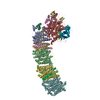
|
|---|---|
| 1 |
|
- Components
Components
-NAD(P)H-quinone oxidoreductase subunit ... , 12 types, 12 molecules ABCEHIJKLMNO
| #1: Protein | Mass: 40565.984 Da / Num. of mol.: 1 / Source method: isolated from a natural source Source: (natural)   Thermosynechococcus elongatus (strain BP-1) (bacteria) Thermosynechococcus elongatus (strain BP-1) (bacteria)Strain: BP-1 References: UniProt: Q8DL32, Translocases; Catalysing the translocation of protons; Linked to oxidoreductase reactions |
|---|---|
| #2: Protein | Mass: 55168.543 Da / Num. of mol.: 1 / Source method: isolated from a natural source Source: (natural)   Thermosynechococcus elongatus (strain BP-1) (bacteria) Thermosynechococcus elongatus (strain BP-1) (bacteria)Strain: BP-1 References: UniProt: Q8DMR6, Translocases; Catalysing the translocation of protons; Linked to oxidoreductase reactions |
| #3: Protein | Mass: 15013.919 Da / Num. of mol.: 1 / Source method: isolated from a natural source Source: (natural)   Thermosynechococcus elongatus (strain BP-1) (bacteria) Thermosynechococcus elongatus (strain BP-1) (bacteria)Strain: BP-1 References: UniProt: Q8DJ02, Translocases; Catalysing the translocation of protons; Linked to oxidoreductase reactions |
| #5: Protein | Mass: 11140.265 Da / Num. of mol.: 1 / Source method: isolated from a natural source Source: (natural)   Thermosynechococcus elongatus (strain BP-1) (bacteria) Thermosynechococcus elongatus (strain BP-1) (bacteria)Strain: BP-1 References: UniProt: Q8DL29, Oxidoreductases; Acting on NADH or NADPH; With a quinone or similar compound as acceptor |
| #8: Protein | Mass: 45271.184 Da / Num. of mol.: 1 / Source method: isolated from a natural source Source: (natural)   Thermosynechococcus elongatus (strain BP-1) (bacteria) Thermosynechococcus elongatus (strain BP-1) (bacteria)Strain: BP-1 References: UniProt: Q8DJD9, Oxidoreductases; Acting on NADH or NADPH; With a quinone or similar compound as acceptor |
| #9: Protein | Mass: 22444.801 Da / Num. of mol.: 1 / Source method: isolated from a natural source Source: (natural)   Thermosynechococcus elongatus (strain BP-1) (bacteria) Thermosynechococcus elongatus (strain BP-1) (bacteria)Strain: BP-1 References: UniProt: Q8DL31, Oxidoreductases; Acting on NADH or NADPH; With a quinone or similar compound as acceptor |
| #10: Protein | Mass: 19363.789 Da / Num. of mol.: 1 / Source method: isolated from a natural source Source: (natural)   Thermosynechococcus elongatus (strain BP-1) (bacteria) Thermosynechococcus elongatus (strain BP-1) (bacteria)Strain: BP-1 References: UniProt: Q8DJ01, Oxidoreductases; Acting on NADH or NADPH; With a quinone or similar compound as acceptor |
| #11: Protein | Mass: 25766.998 Da / Num. of mol.: 1 / Source method: isolated from a natural source Source: (natural)   Thermosynechococcus elongatus (strain BP-1) (bacteria) Thermosynechococcus elongatus (strain BP-1) (bacteria)Strain: BP-1 References: UniProt: Q8DKZ4, Oxidoreductases; Acting on NADH or NADPH; With a quinone or similar compound as acceptor |
| #12: Protein | Mass: 8575.137 Da / Num. of mol.: 1 / Source method: isolated from a natural source Source: (natural)   Thermosynechococcus elongatus (strain BP-1) (bacteria) Thermosynechococcus elongatus (strain BP-1) (bacteria)Strain: BP-1 References: UniProt: Q8DKZ3, Oxidoreductases; Acting on NADH or NADPH; With a quinone or similar compound as acceptor |
| #13: Protein | Mass: 12584.056 Da / Num. of mol.: 1 / Source method: isolated from a natural source Source: (natural)   Thermosynechococcus elongatus (strain BP-1) (bacteria) Thermosynechococcus elongatus (strain BP-1) (bacteria)Strain: BP-1 References: UniProt: Q8DLN5, Oxidoreductases; Acting on NADH or NADPH; With a quinone or similar compound as acceptor |
| #14: Protein | Mass: 16656.182 Da / Num. of mol.: 1 / Source method: isolated from a natural source Source: (natural)   Thermosynechococcus elongatus (strain BP-1) (bacteria) Thermosynechococcus elongatus (strain BP-1) (bacteria)Strain: BP-1 References: UniProt: Q8DJU2, Oxidoreductases; Acting on NADH or NADPH; With a quinone or similar compound as acceptor |
| #15: Protein | Mass: 7877.076 Da / Num. of mol.: 1 / Source method: isolated from a natural source Source: (natural)   Thermosynechococcus elongatus (strain BP-1) (bacteria) Thermosynechococcus elongatus (strain BP-1) (bacteria)Strain: BP-1 References: UniProt: Q8DMU4, Oxidoreductases; Acting on NADH or NADPH; With a quinone or similar compound as acceptor |
-Protein , 4 types, 4 molecules DFGS
| #4: Protein | Mass: 57847.504 Da / Num. of mol.: 1 / Source method: isolated from a natural source Source: (natural)   Thermosynechococcus elongatus (strain BP-1) (bacteria) Thermosynechococcus elongatus (strain BP-1) (bacteria)Strain: BP-1 References: UniProt: Q8DKY0, Oxidoreductases; Acting on NADH or NADPH; With a quinone or similar compound as acceptor |
|---|---|
| #6: Protein | Mass: 72025.352 Da / Num. of mol.: 1 / Source method: isolated from a natural source Source: (natural)   Thermosynechococcus elongatus (strain BP-1) (bacteria) Thermosynechococcus elongatus (strain BP-1) (bacteria)Strain: BP-1 / References: UniProt: Q8DKX9 |
| #7: Protein | Mass: 21580.568 Da / Num. of mol.: 1 / Source method: isolated from a natural source Source: (natural)   Thermosynechococcus elongatus (strain BP-1) (bacteria) Thermosynechococcus elongatus (strain BP-1) (bacteria)Strain: BP-1 / References: UniProt: Q8DL30, NADH dehydrogenase (quinone) |
| #18: Protein | Mass: 12462.559 Da / Num. of mol.: 1 / Source method: isolated from a natural source Source: (natural)   Thermosynechococcus elongatus (strain BP-1) (bacteria) Thermosynechococcus elongatus (strain BP-1) (bacteria)Strain: BP-1 / References: UniProt: Q8DL61 |
-Proton-translocating NADH-quinone dehydrogenase subunit ... , 2 types, 2 molecules PQ
| #16: Protein/peptide | Mass: 4878.649 Da / Num. of mol.: 1 / Source method: isolated from a natural source Source: (natural)   Thermosynechococcus elongatus (strain BP-1) (bacteria) Thermosynechococcus elongatus (strain BP-1) (bacteria)Strain: BP-1 / References: UniProt: V5V507 |
|---|---|
| #17: Protein/peptide | Mass: 4844.698 Da / Num. of mol.: 1 / Source method: isolated from a natural source Source: (natural)   Thermosynechococcus elongatus (strain BP-1) (bacteria) Thermosynechococcus elongatus (strain BP-1) (bacteria)Strain: BP-1 |
-Non-polymers , 1 types, 3 molecules 
| #19: Chemical |
|---|
-Details
| Has protein modification | Y |
|---|
-Experimental details
-Experiment
| Experiment | Method: ELECTRON MICROSCOPY |
|---|---|
| EM experiment | Aggregation state: PARTICLE / 3D reconstruction method: single particle reconstruction |
- Sample preparation
Sample preparation
| Component | Name: NAD(P)H dehydrogenase-like complex (NDH/NDH-1_1/NDH1L)from T.elongatus Type: COMPLEX / Entity ID: #1-#8, #10-#18 / Source: NATURAL | ||||||||||||||||
|---|---|---|---|---|---|---|---|---|---|---|---|---|---|---|---|---|---|
| Molecular weight | Value: 0.42 MDa / Experimental value: YES | ||||||||||||||||
| Source (natural) | Organism:   Thermosynechococcus elongatus BP-1 (bacteria) Thermosynechococcus elongatus BP-1 (bacteria) | ||||||||||||||||
| Buffer solution | pH: 6 | ||||||||||||||||
| Buffer component |
| ||||||||||||||||
| Specimen | Conc.: 0.03 mg/ml / Embedding applied: NO / Shadowing applied: NO / Staining applied: NO / Vitrification applied: YES | ||||||||||||||||
| Specimen support | Grid material: COPPER / Grid mesh size: 300 divisions/in. / Grid type: Quantifoil R2/2 | ||||||||||||||||
| Vitrification | Instrument: FEI VITROBOT MARK IV / Cryogen name: ETHANE / Humidity: 100 % / Chamber temperature: 295 K Details: incubate on grid for 30 seconds and blot 2.5 seconds before plunging |
- Electron microscopy imaging
Electron microscopy imaging
| Experimental equipment |  Model: Titan Krios / Image courtesy: FEI Company |
|---|---|
| Microscopy | Model: FEI TITAN KRIOS |
| Electron gun | Electron source:  FIELD EMISSION GUN / Accelerating voltage: 300 kV / Illumination mode: FLOOD BEAM FIELD EMISSION GUN / Accelerating voltage: 300 kV / Illumination mode: FLOOD BEAM |
| Electron lens | Mode: BRIGHT FIELD / Cs: 2.7 mm |
| Specimen holder | Cryogen: NITROGEN / Specimen holder model: FEI TITAN KRIOS AUTOGRID HOLDER |
| Image recording | Average exposure time: 0.2 sec. / Electron dose: 60 e/Å2 / Detector mode: SUPER-RESOLUTION / Film or detector model: GATAN K2 SUMMIT (4k x 4k) / Num. of grids imaged: 1 / Num. of real images: 1385 / Details: Three image per hole, focusing once per hole. |
| EM imaging optics | Energyfilter name: GIF Quantum LS / Energyfilter slit width: 25 eV |
| Image scans | Movie frames/image: 30 / Used frames/image: 1-30 |
- Processing
Processing
| Software | Name: PHENIX / Version: (1.13_2998: phenix.real_space_refine) / Classification: refinement | |||||||||||||||||||||||||||||||||||||||||||||||||||||||
|---|---|---|---|---|---|---|---|---|---|---|---|---|---|---|---|---|---|---|---|---|---|---|---|---|---|---|---|---|---|---|---|---|---|---|---|---|---|---|---|---|---|---|---|---|---|---|---|---|---|---|---|---|---|---|---|---|
| EM software |
| |||||||||||||||||||||||||||||||||||||||||||||||||||||||
| Image processing | Details: Super-resolution movies were aligned, exposure-weighted, and Fourier cropped to the physical pixel size. | |||||||||||||||||||||||||||||||||||||||||||||||||||||||
| CTF correction | Type: PHASE FLIPPING AND AMPLITUDE CORRECTION | |||||||||||||||||||||||||||||||||||||||||||||||||||||||
| Particle selection | Num. of particles selected: 98145 | |||||||||||||||||||||||||||||||||||||||||||||||||||||||
| Symmetry | Point symmetry: C1 (asymmetric) | |||||||||||||||||||||||||||||||||||||||||||||||||||||||
| 3D reconstruction | Resolution: 3.5 Å / Resolution method: FSC 0.143 CUT-OFF / Num. of particles: 34655 / Algorithm: BACK PROJECTION / Symmetry type: POINT | |||||||||||||||||||||||||||||||||||||||||||||||||||||||
| Atomic model building | B value: 20 / Protocol: RIGID BODY FIT / Space: REAL / Target criteria: Corelation coefficient | |||||||||||||||||||||||||||||||||||||||||||||||||||||||
| Atomic model building | PDB-ID: 6NBQ Accession code: 6NBQ / Source name: PDB / Type: experimental model |
 Movie
Movie Controller
Controller



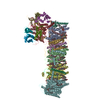

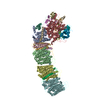


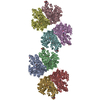
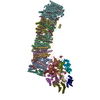

 PDBj
PDBj








